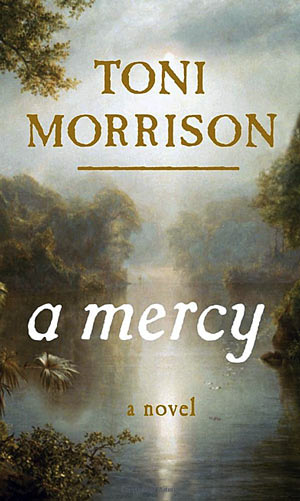Dr. Toni Morrison is renowned for positing her novels amidst a singular effort to answer questions that perplex and pull at her being. The question at the core of A Mercy is rooted in Morrison’s own academic inquiry and excavation into U.S. American history and more particularly the nation’s slave history. Morrison’s body of work centralizes around characters and families torn apart amidst pre- and post-colonial constructions of race in the U.S.
As the sage and crooning visionary approaches her seat in the center of the empty Symphony Center stage in Chicago, a single glass of water and a lush vase of lilacs placed beside her, she smiles and cautiously walks, with somewhat of a limp. Her long gray braids remind us of her long life in letters and the historic significance of this moment. The audience rises to greet her with a standing ovation. The air thins, and chills set through arms amongst soft sighs of admiration and awe.
Morrison lightheartedly lectures before her reading from A Mercy. She forgets the name of the Bacon Rebelion and asks the audience for assistance. She talks on the extensive research conducted and critical analysis integral to her compilation of fact and fiction in her latest work. She compliments Chicago for its hard work and dedication in presenting A Mercy for the One-Book-One-Chicago citywide book club. Her lecture meanders but stays tied on the topic of race and its constructions in the U.S. Since her initial interest in The Bluest Eye, Morrison confides, the consequences of racism and its “frequently lethal” affects have preoccupied her work. “We have to know what [racism] feels like. We have to know what it looks like,” Morrison notes.
“If a child is born innocent [of prejudice and racist ideology], what about a nation? In the beginning of this nation,” Morrison posits our origins as perhaps less void of strict racial codes and demarcations. She deliberately sets her novel in 1690, two years before the Salem Witch Trials in an attempt to delve deeper into the heart of her question on race and racism in the pre-American identity.
Morrison highlights the Bacon’s Rebellion (1676) as a peoples’ rebellion, marked by its unique blend of landed gentry, Native American insurgents, white indentured servants and Black slaves. The unified front rose against the Governor of Virginia, only to be squashed soon after. With all their leaders executed, Morrison posits the moments after the rebellion as seminal in constructions of racial hierarchy in the U.S. After the rebellion, ‘it became law that no black persons could own or carry weapons and more importantly that any white, including those indentured servants, could kill any black person for any reason,’ as she paraphrases the laws.
Morrison assesses that, “The function of racism is just to function. It has no root except to gain power. And thrust me,” she confides in the audience, “not yours, not your power.” The audience hums its approval as Morrison continues. “Our job as human beings who have language -conflated though that language may be- our job is to become better human beings.”
As a child growing up in the great depression, Morrison shares, US Americans were referred to as citizens. She recalls the romanticized view of the hobo as a wandering, free spirit, unlike the welfare obsessed, “brother’s keeper” diction of today’s media concerns. She describes how she saw in the ’60s the US American transformed from a citizen into a consumer. We were then measured by what we purchased and owned. Whereas in her youth, people gave freely to the homeless, what little they had, in solidarity since no one had anything. And finally she noted how today, we are identified as tax payers, concerned with holding on to what little is ours.
Morrison’s concern with evil, and the wickedness of giving yourself entirely to another person out of misguided love, in her novel A Mercy, stems from her notion that “evil is not interesting, it requires dance and music and spectacle to attract and to impress.” Her words stand as a clear indictment of the US mainstream media and entertainment industry, aimed at keeping its taxpayer-consumer-citizens distracted and distraught; placated by what little we can have and hold over those have-nots and “at least we aren’t” those others.
In Morrison’s warnings and wisdom there exists potential, a plea for humanism. Here, the theorist and academic, novelist and philosopher, artist and writer seeps out into the collective unconscious of the lavish Symphony hall. Morrison’s words echo beyond the speakers and drift along the ornate decor and historic moldings, where notes of the world’s great composers and instrumentalists have sat and resonated for decades. Morrison’s hopes for humanity verve with the melodies of symphonies and singers who have played this hall before her. “My suspicion -that has been validated in some quarters- is an addition to Darwinism. There is a gene among all species, a deviance towards self-sacrifice, for the improvement of ones species. All species long to better their kind with each generation. No generation wants to be like the dry, leafy generation before them. Like bees and ants and all sorts of other insects who sacrifice procreation for the betterment of the next generation,” Morrison speculates, “there must be a gene for altruism within the human race.”
As she opens her book to begin reading from A Mercy, her voice softens. The room settles, and her cricketing voice sweeps over the audience like a spell. Some follow along in their own copies of the novel, and others sit, watching. Some slip into dreams, their eyes closed and their minds fixed on the powerful voice enveloping their minds.

Beautiful analysis, Jose Luis!